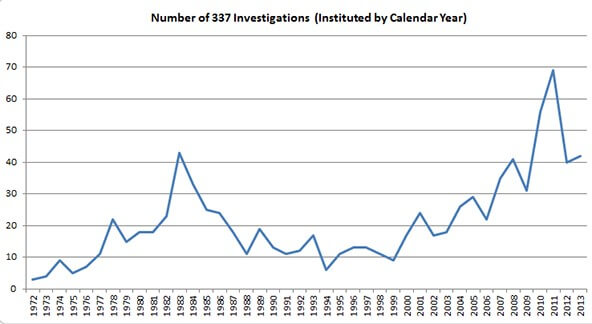Month: June 2017
ITC Patent Litigation: Don’t Let Copycat Products Enter the USA

What do barcode readers, pool enclosures, televisions and backpack chairs all have in common? Each of these products has been investigated by a federal agency for unlawful importation into the United States. The unlawful part? They’ve all been charged with intellectual property infringement.
Section 337 and the ITC
The agency responsible for IP-based import investigations in the U.S. is the International Trade Commission (ITC). The piece of legislation that this agency deals with most often is Section 337 of Title 19. Section 337 prohibits the importation or sale of imported articles that infringe a valid and enforceable U.S. patent, trademark or copyright.
According to records maintained by the ITC, the amount of Section 337 investigations launched each year has been on the rise for the past 50 years:
- Before 1977 = less than 10 investigations launched per year
- 1978 = 22 investigations launched
- 1983 = 43 investigations launched
- 2011 = 69 investigations launched (record high)

In 2015, the most popular type of ITC investigation involved computer and telecommunications products. These products accounted for over a quarter (27%) of that year’s Section 337 investigations – the same amount as the next three product categories combined!
Opening an investigation
Nearly 90% of Section 337 investigations involve international patent infringement disputes. If a U.S. patent owner feels that a Section 337 violation has occurred, they can file a complaint with the ITC. The complaint will be reviewed by the ITC’s Office of Unfair Import Investigations (OUII), which will decide whether or not to launch an investigation. If an investigation is initiated, the ITC will publish a Notice of Investigation in the Federal Register.
Approximately 45% of Section 337 cases go to trial. These patent litigation trials typically take around 18 months to resolve and include the full range of court actions, including formal discovery, pretrial hearings and motions, trial by an Administrative Law Judge (no jury), post-trial briefs, Judge’s decision, ITC decision, and appeals.
Language challenges in ITC litigation
In ITC litigation, there is the additional challenge of working with one or more international parties. Discovery, in particular, can become a very complex and time-consuming process. For example, there can be hundreds or even thousands of patent documents in one or more foreign languages that require legal translation; depositions can take place all over the world; and everything needs to be translated into English for review by the ITC.
“Litigating in the ITC presents a unique challenge,” says Finnegan, a top IP law firm, because it involves solving “technologically complicated case[s] in a short period of time, in a pressure-packed forum that can make or break the commercial success of the products at issue.” In such an environment, seeking professional translation services to assist with cross-border discovery is no joke.
A language service provider (LSP) can utilize specialized tools and filtering techniques to cull large data sets into more manageable chunks of case-relevant information. Then machine translation (MT) can be used to determine the “gist” of what each document contains, so that it become clear which ones require more accurate human translation by subject matter experts (SME). This process guarantees accurate, high quality and fast translations, which are absolutely critical – anything less could have a serious impact on the outcome of the case.
Results of ITC litigation
Once the ITC Judge has reviewed all case information (with all legal documents translated into English) and heard both sides of the argument, he or she will rule on the case. Then, a Notice of Termination will be published in the Federal Register. If the Judge decides that a Section 337 violation did occur, the ITC can issue one or both of the following remedial orders:
- A cease-and-desist order against named importers – this type of order is enforced by the ITC.
- An exclusion order barring any further importation of the products at issue – this type of order is enforced by U.S. Customs and Border Protection. (You can view the current list of exclusion orders here.)
Importers who do not comply with a remedial order can face fines costing millions of dollars.
Get the latest insights delivered to your inbox
How to Globalize Video Marketing Through Translations

4x as many people prefer to watch videos about products than to read about them, and 40% say they are more likely to make a purchase on their phones if they watch a video first. Internet videos already reach more people than any individual U.S. cable network, and 75% of business executives watch work-related videos at least once a week.
YouTube, the largest video-sharing platform, accounts for more than a billion viewers and millions of viewing hours each day. Part of their effort to reach global viewers is comprehensive localization and translation of their user interface, with YouTube offering local services in 88 countries and in 76 languages.
Videos are clearly one of the most effective means of reaching global consumers. Ideally, they are entertaining and informative, engaging and immersive. Done right, and with the help of translation companies, videos should be an indispensable weapon in any marketer’s arsenal. The question is no longer whether or not to use videos – but how to make them cost-efficient and globally attractive in order to maximize your return on investment (ROI).
Why videos work
Videos can resonate with your target audience more effectively than any other medium. As marketing expert, Anne Hadley said, “Video adds a pulse to your content. It makes your story tangible and real. So why wouldn’t we all embrace it?” Especially when “embracing it” can translate directly into increased sales and market share. For example:
- Studies show that including video on a landing page can increase conversions by 80%. You can improve that rate even further by translating the website and landing page to appeal to an array of local audiences.
- Adding video to your translated website increases viewers’ time on-site and the likelihood that your website will appear on the first page of Google’s search results, a boon to your SEO efforts. (Search engines track the amount of time a visitor spends on a site before returning to the search results page. The more time someone spends on your site, the more relevant the link becomes to the search engine.)
- Sending an email with the word video in the subject line increases opens by 19% and click-throughs by 65%. It also reduces unsubscribes by 26%.
People are also much more likely to socially share video content over any other medium. Millennials, in particular, prefer to watch videos on their phones and are surprisingly likely to watch company videos when shopping online.
Video ROI and localization
While videos are clearly effective in boosting sales and brand recognition, they are also expensive. A great way to maximize ROI on a corporate video is to localize the content and distribute the video internationally, via social media to global audiences or directly to your employees or potential partners/investors overseas. But to avoid embarrassment and even potential liability, it’s critical to get your video professionally translated and localized.
Working with a language service provider (LSP) from the very beginning can help you determine how your message might be received in different locations, particularly those with distinct cultural differences. Ideally, this research should be conducted before the video is produced so that the content is appropriate for all intended audiences.
Strategies for localizing video
Targeting vastly different audiences with a single video is obviously not as effective as creating different versions for different audiences. But creating customized videos for each region is costly and may not always be an option. Here are three alternative strategies:
- Animation – Create a video that doesn’t rely on live actors. Animation can be engaging and has the advantage of narration – the narrator can speak in any language without needing to adjust the on-screen content to match.
- Dubbing – If actors are integral to the video, the next option to consider is dubbing. Voiceover talent records new dialogue in the target language that replaces the original spoken dialogue. Dubbing is a great way to localize your video for different audiences, but depending on the number of actors/voices in the video, it can be quite expensive.
- Subtitles – A third option is to use localized subtitles. This works for videos with or without actors. Subtitling is less expensive than dubbing and relatively easy to add to an existing video. The drawback, however, is that many viewers are reluctant to watch videos that require reading, and subtitles can distract from the visual message you are trying to convey. If your video is fast-paced, following the action and reading subtitles simultaneously might cause your intended audience to tune out.
Videos bridge the divide
Whether the videos are animated, dubbed, or subtitled, they are likely to be clicked and shared if they resonate with your target audience. In addition to obtaining professional subtitling or dubbing services, make sure to tackle issues of interest to the local audience and use cultural references that will appeal to your viewers. The more people feel represented in the videos, the more likely they are to share them.
Remember, ensuring cultural fluidity starts at the very beginning. A premiere LSP with proven video translation experience can help localize your content effectively so that it resonates with diverse audiences and even goes viral.
Get the latest insights delivered to your inbox
The Rise of Telehealth

If you watch any TV hospital dramas, you may have seen this already – a talking robot wandering the halls controlled by a remote doctor who is pictured on a computer screen at the head of the robot. These machines may look odd, but they are going to get a lot more popular over the next few decades. Telehealth is one of the most effective ways to increase health care availability throughout the United States, especially in rural and isolated communities where good doctors are hard to find.
What is telehealth?
Remote-controlled robots are one (pretty neat) aspect of telehealth, but the term covers much more than that. The U.S. Department of Health and Human Services defines it as “the use of electronic information and telecommunications technologies to support and promote long-distance clinical health care, patient and professional health-related education, public health and health administration.”
Modalities of telehealth
There are four main ways to implement telehealth services:
- Live video – Real-time interaction between a patient or caregiver and a medical specialist. This can include remote diagnosis, treatment or follow-up.
- Store-and-forward – Pre-recorded videos or images that are sent through a secure connection to a remote specialist who evaluates the information and sends a response back through the secure system.
- Remote patient monitoring (RPM) – Medical staff give a monitoring device to a patient, who can use it to record health and medical data from home. The data is transmitted on a regular basis (sometimes daily or hourly) to the medical provider for continuous monitoring and support.
- Mobile health (mHealth) – Combines health care services and education with mobile applications, such as targeted text messages, emails or alerts.
Benefits
Telehealth brings experienced medical care right into patients’ homes, or at least their hometowns. This is a huge plus for patients because:
- They gain access to medical experts in cities they can’t travel to due to mobility issues or financial hardship – a critical factor for the 16% of Americans who live in rural areas.
- Doctors and medical service providers can monitor patients without the need for in-office appointments – and the co-pays that go along with them.
- Educational tools and support are available at the touch of a button.
Physician shortage
The benefits of telehealth will become increasingly important as we get closer to 2025. By this time, the Association of American Medical Colleges (AAMC) predicts there could be a shortage of up to 94,700 physicians in the United States. The aging “Baby Boomer” population, in particular, will have a major impact on the medical industry over the next few years. Not only will the need for senior services increase, but the supply of caregivers will simultaneously decrease because over one-third of all current physicians are expected to retire in the next decade. “Physicians between ages 65 and 75 account for 11% of the active workforce, and those between ages 55 and 64 make up nearly 26% of the active workforce,” the AAMC reports. As the ratio of doctors to patients decreases, the appropriate use of technology in patient care will help close the gap and allow doctors to save in-office appointments only for those patients who truly need it.
Language challenges
Any hospital or health care facility that receives federal funding is required to offer language access programs for patients who don’t speak English fluently. With nearly 1 in 5 U.S. residents speaking a foreign language in their homes (Spanish and Chinese are the most popular), the implementation of increased telehealth services needs to take patients’ language needs into account. Telehealth services will need to incorporate translated websites, mobile apps and communications, medical documents and devices, as well as simultaneous interpretation of live video through on-site medical interpreters. One alternative to translating healthcare apps is to use pictures and icons. However, even these must take cultural differences into consideration.
What are my options?
Check with your health care provider to see what telehealth services they have available. You can use patient-focused technologies to take greater control of your own health. Even if you’re not ready to talk to a doctor through a robot head computer screen, there could be other telehealth resources that could help you in your day-to-day life (e.g. educational websites, automated appointment reminders, newsletters that are specific to your health needs, and more). With demands increasing on the healthcare system and a growing shortage of healthcare professionals, telehealth services could be your best bet for quality local care at a reasonable cost.
Get the latest insights delivered to your inbox
5 Best Uses of Tech for Law Firms

Technology has completely transformed how we do business. IT has changed how companies connect and communicate with their clients, and a company’s “storefront” online is now just as important as its physical office space. This is just as true for law firms as it is for any other business. Modern applications of technology can bring in new clients and help with expanding clientele, increasing revenue, and even improving internal engagement from your own team. Here are 5 great ways to use tech to generate new business and improve efficiency at your law firm:
1. Build a client portal
Static websites are old news. To optimize legal business today, you need to offer your clients this critical business tool. A portal allows clients to login to a customized section of your website where they can view, change and manage current and future projects. You determine what your clients have access to and when they have access to it. For example, a portal can include meeting calendars, document sharing, contact management and private messaging services.
Tip: Adding a client portal to your website makes collaboration easier and provides 24/7 access for your clients.
2. Write a blog
Become a resource for potential clients. Law firms are setting themselves apart by establishing a knowledgeable and impressive online presence. By covering important issues and addressing relevant or newsworthy topics, you can engage new readers and expand brand awareness for your firm. High quality original content will increase your visibility as your readers do the marketing for you by sharing it on LinkedIn, Facebook or via email. As more readers turn to your blog for answers and advice, some will inevitably bring in new business – either via referral or by becoming new clients themselves. And from a technical perspective, the more you blog, the more pages and links will be indexed by search engines – which increases the chances of your firm showing up on page 1 of online search results.
Tip: If your firm starts a weekly blog, after 1 year you can expect your website traffic to increase by 53%.
3. Create an app
The days of handing out flyers and printed ads are coming to an end. Today, the best way to communicate with your clients is through their mobile device. According to the Pew Research Center, 77% of Americans own smartphones – and the time we spend using them is up to 5 hours per day (that’s more time than we spend watching TV). If your firm doesn’t have a mobile interface, you’re missing a major opportunity to communicate with existing and potential new clients. You can start by creating an app with a simple menu – e.g. background information on the firm, contact us page and access to the firm’s blog. From there you can get creative and build out all kinds of innovative new features. For example, a services page with a fee calculator or a community page for legal questions and comments – the possibilities are endless.
Tip: Annual maintenance costs of a published app can be around 20% of your app’s initial development costs.
4. Accelerate review
Most major law firms already rely on e-Discovery software, such as kCura’s Relativity platform, to accelerate review and manage large volumes of data. These programs can assist with matters related to litigation, internal investigation, compliance, etc. You can get more out of legal software by utilizing the available plug-ins. For example, Morningside’s Language Connect plug-in helps expedite the translation of foreign language documents by allowing users to instantly send multilingual files for evaluation and translation without leaving the Relativity environment. Human, machine or hybrid translation services are available in more than 100 languages through Language Connect.
Tip: IBM has built an AI program named “Ross” that you can hire to do legal research for your firm.
5. Streamline compliance
Use certified eLearning training programs to take the place of in-person CLE or CPD seminars. These online courses are much more convenient for lawyers and their staff. As long as they have internet access, eLearning can be done anytime, anywhere, and in any language. By providing automated, easy-to-access and interactive training courses, employees are more likely to retain new knowledge and compliance officers can more easily track and monitor course completions.
Tip: If you are a multinational firm with a global workforce, translating onboarding and compliance materials often yields higher profits for the firm.

